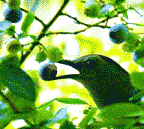|
|
 |
||||||||||
|
|||||||||||
|
|||||||||||
Blueberries Satisfy Local HungerJuly’s the time prudent gardeners and lucky foragers taste these sweetsYou’ve probably heard the news: Local is in. Literary superstar Barbara Kingsolver and other best-selling authors are writing books about food, reflecting on where their food comes from, not just how it is grown. Local is the new organic. Mixed into the discussion are a variety of related topics: weather and climate; energy and its costs; ecological calamities such as the decline of honeybees. These discussions are likely tinged with uncertainty, concern and fear. The hard freezes of April hurt apple, peach and blueberry crops, especially in the South, and stirred up angst among growers and consumers. Around the same time, we were hearing dire reports about the mysterious decline of commercially bred honeybees, which we depend on for the pollination of so many of the foods we eat. Walking around the yard, I think about these things, too. The flowers and shrubs I’ve planted over nine years attract lots of bumblebees and other types of bees. Bees and other insects pollinate squash, cucumber, tomatoes and beans growing nearby. I didn’t intentionally plant flowers near crops to attract bees for pollination, but I’ve since read about the boost such plantings give growers. A blueberry plant growing in a pot was not hurt by the freeze and is producing a fair number of berries. Not nearly enough to satisfy my appetite, but they are locally grown and they taste great. Just ask the robins and catbirds that steal two berries for each one we pick. Had the early spring freezes or some other disaster destroyed all of the commercially grown berries, our small crop would be even dearer to us. Despite the freeze we have found blueberries at the grocery store, and they are not as pricey as I feared they would be. The last half-pint we bought came from Hammonton, N.J., the blueberry capital of the world. There, acres and acres of bushes are grown in monoculture fields. The local crowd, count me among them, would prefer berries from nearby growers. This tribe is wary of large-scale agriculture, whether or not it’s organic. But this bent begs a number of questions: What are we willing to give up? Coffee, chocolate, wine, blueberries? If forced to limit choices, would we change our views on pesticides and the use of non-organic fertilizers? Would I turn on my old friend the catbird in the struggle for the berries? Local ChoicesThe first question is how to make local choices. Territorial Seed Company sells a blueberry called Bluecrop, advertised as producing consistently heavy yields of high-quality berries. Or you might try Rubel, which is closer to the wild varieties. It produces a sweet, deep blue fruit. Local garden centers are another good source for plants: consider a high-bush or rabbit-eye variety. Speaking of wild blueberries (genus Vaccinium), the heath barrens of the Dolly Sods Wilderness area in West Virginia is a five-hour drive, but if you visit in early August you can pick all the wild blueberries and huckleberries that you can eat. There is no better place that I know of to gather wild blueberries. Park near Bear Rocks, and bring a bucket. Walking on the Appalachian Trail in Maryland on the Fourth of July, we picked a few wild blueberries growing by the trail. They were good. A few minutes later, for no reason that I can understand, I was attacked by bees and stung three times. The plants self-pollinate, so the Hammonton growers can relax about the bees — though I shouldn’t have. |
|||||||||||
|
|||||||||||
|
|
|||||||||||
|
© COPYRIGHT 2007 by New Bay Enterprises, Inc. All rights reserved. |
|||||||||||

